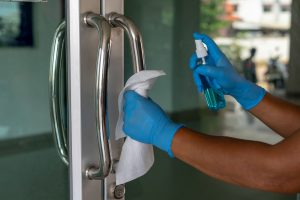A costume studio shares its enhanced disinfecting and sanitizing protocols, and explains how it minimizes the potential chemical hazards.

Photo credit: iStock.com/neptunestocks
Enhanced cleaning procedures are an important part of preventing COVID-19 transmission at work. I spoke with a friend about how his workplace is carrying out the extra measures. He is a shop foreman at a company that makes specialized costumes that need to be custom fit. Since the fittings are done on-premises, they do everything they can to minimize the spread of COVID-19 and keep everyone at their studio healthy — including their staff and the actors who visit.
“The actors have already completed COVID-19 tests and taken many precautions to stay healthy,” says my friend, who prefers to remain anonymous. “We’ve got to be able to provide them with a sanitized environment.”
Safety solutions for disinfecting
In addition to regular cleaning, all surfaces in their costume room are sprayed with a disinfecting product. This information sheet from WorkSafeBC outlines some information on cleaning and disinfecting surfaces.
With so many disinfectants on the market, employers in all industries need to keep workers’ safety in mind when selecting which one to use. See this risk advisory from WorkSafeBC that explains how to reduce risk to workers who use cleaners, disinfectants, and sanitizers.
Some of the recommendations include the following:
- Avoid products that include hazardous ingredients, such as phenols, Didecyldimethylammonium chloride (DDAC), glutaral, and peracetic acid.
- Only use spray (aerosolization) methods if a risk assessment has been conducted and the product can be applied according to the manufacturer’s instructions.
- Read the manufacturer’s instructions and product label to determine the required dilution (strength) for your use.
- Provide workers with the necessary PPE to safely prepare and apply the product.
Cleaning and disinfecting the costume room
My friend’s company chose a particular disinfecting product after hearing about it from a neighbouring business and reviewing the product label. It was the least hazardous product and still effective. To apply, they spray all surfaces in their costume room with a fine mist from a refillable tank of fluid in a backpack. They make sure to protect themselves for the application, wearing goggles, gloves, and an N95 mask for the procedure.
They also ensure that there is proper ventilation, staff are familiar with the manufacturer’s instructions on the label, and they know how to properly clean up a spill, if necessary.
Signage is posted to ensure that no employees enter the area where actors will be fitted for specialized costumes. The room is off limits to everyone during spraying.
This is one example of the many health and safety solutions that are happening in the motion picture and TV industry. I included others in my recent post Shooting for safety on motion picture and TV sets.
Disinfecting is just part of the plan
Cleaning and disinfecting is only part of the costume company’s safety plan for reducing the risk of COVID-19. Everyone at the studio completes a required daily health check before entering, and they also get forehead temperature checks. The costume makers also wear synthetic paper suits, face shields, N95 masks, and gloves when they are fitting actors for costumes.
Every workplace may have different needs and requirements for a safety plan, and I was happy to hear what this business is doing to limit the spread of COVID-19 in their workplace.


